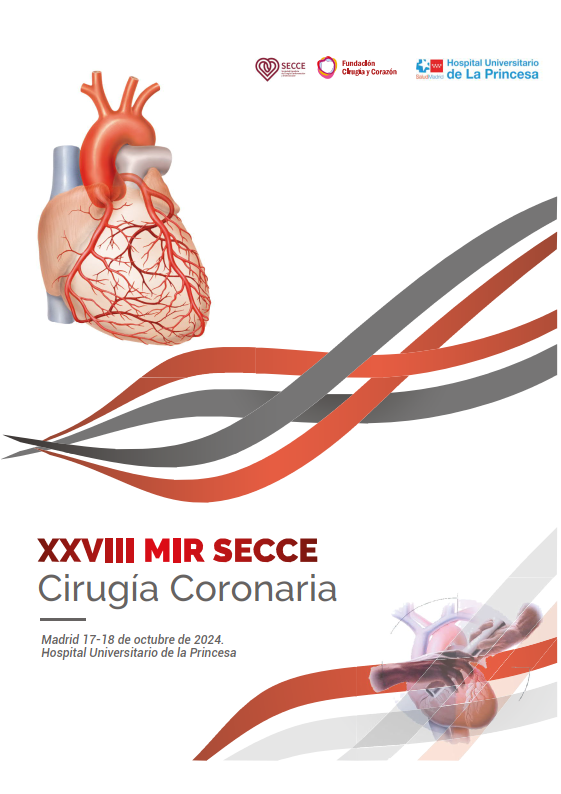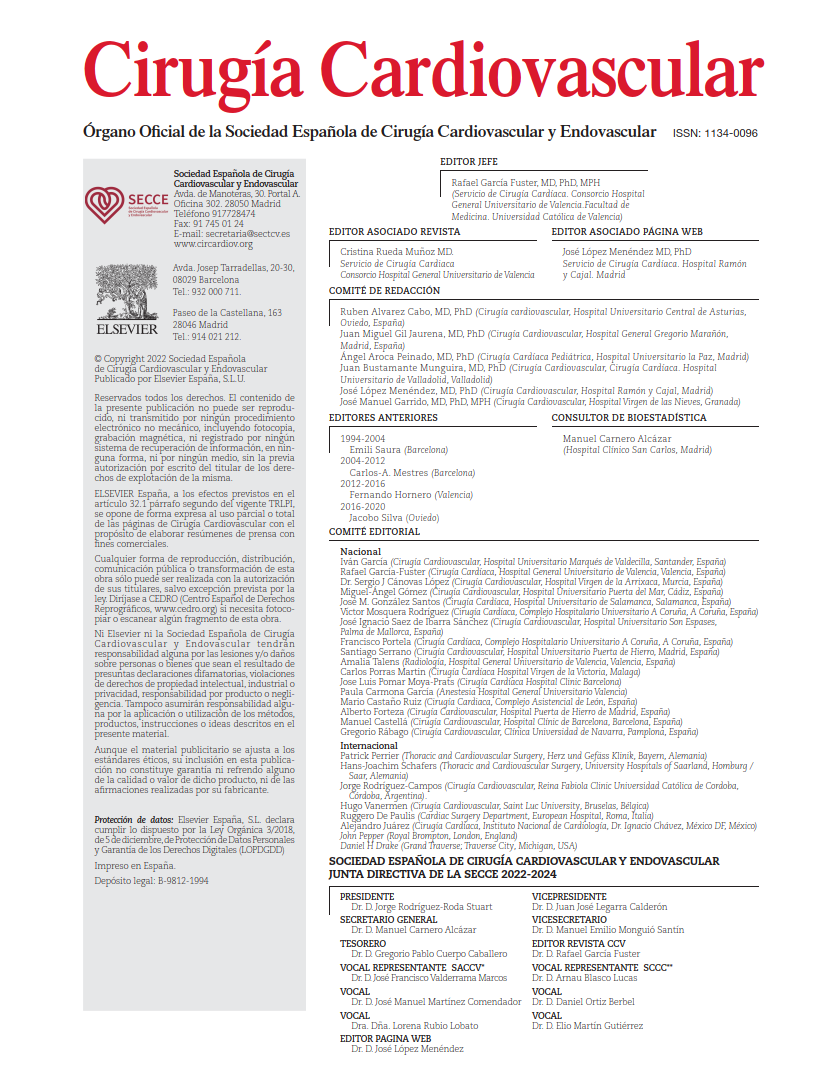The expanding indications for transcatheter aortic valve implantation (TAVI) have led to its increasing use in younger patients with low surgical risk. However, this trend inevitably carries a consequence: the growing number of reoperations due to structural valve deterioration or complications such as infective endocarditis.
Surgical explantation of TAVI is no longer an exceptional procedure but an essential skill in contemporary cardiac surgery. Far from being a trivial maneuver, it requires meticulous preparation, detailed anatomical knowledge, and mastery of various surgical techniques tailored to the type of prosthesis and patient-specific conditions.
This article is based on two complementary videos illustrating different clinical scenarios of TAVI explantation: one due to endocarditis with perivalvular abscess (published in MMCTS), and another due to severe regurgitation and paravalvular leak in a failed TAVI case (published on CTSNet). Together with recent literature, these resources help identify critical steps, key surgical maneuvers, and practical insights for safely addressing these increasingly frequent cases.
In the first video (Davidavicius et al., MMCTS), a case of Enterococcus faecalis endocarditis on a CoreValve Evolut R34 is presented, complicated by perivalvular abscess and severe aortic regurgitation. The explantation process can be seen between minutes 2:22 and 5:51, with a key feature being the progressive “crimping” technique using sutures to reduce the stent diameter and facilitate dissection without injuring the aortic root.
Starting at minute 2:27, the upper cells of the Evolut stent frame are identified and a continuous 0 silk blue waxed suture is passed circumferentially through them. The suture is tied to reduce the stent diameter by centripetal traction. A second pass is then performed through the previously unused stent cells, completing a tobacco-pouch–like closure. This maneuver significantly facilitates blunt dissection between the stent and the aortic wall (min 3:39), often aided by a blunt hook to allow more precise progression. Once the upper portion of the stent is dissected, additional 0 silk sutures are placed approximately 2 cm below the initial level, repeating the circumferential reduction technique to enable dissection down to the aortic root. Native valve excision begins at minute 5:01 using scissors and a spatula, with the complete explanted block (Evolut valve and native leaflets) visible at minute 5:55.
A systematic annular decalcification is then performed as in conventional valve surgery (min 6:46). Before implanting the new surgical prosthesis, the abscess-related defect is addressed. External dissection of the left aortic sinus is carried out (min 8:26), followed by implantation of a heterologous pericardial patch both on the internal and external surfaces of the annulus (min 9:03), ensuring durable and tension-free closure.
In the second video (CTSNet, 2021), a 62-year-old man with multiple comorbidities and a CoreValve Evolut R29 implanted 3.5 years earlier presented with severe aortic regurgitation and paravalvular leak following an acute myocardial infarction. The surgery was performed via median sternotomy with right axillary artery cannulation to allow high aortic clamping and sufficient space to perform the aortotomy approximately 5 mm above the top edge of the stent frame.
Valve explantation (min 2:50) required extensive endarterectomy due to stent integration into the aortic wall, a common finding in self-expanding valves implanted over one year prior. A dissection plane was carefully established using a Penfield spatula to achieve circumferential mobilization of the stent. The prosthesis was crushed using two Kocher clamps applied perpendicularly to allow controlled extraction. The native leaflets were then resected, and annular decalcification was performed using Rongeur forceps (min 4:26). Finally, a surgical bioprosthesis was implanted in the standard fashion.
The authors emphasize that TAVI explantation should no longer be regarded as exceptional and must be integrated into the routine skill set of the modern cardiac surgeon. They stress the importance of careful preoperative planning, understanding of prosthesis design (self-expanding vs balloon-expandable), and the use of specific technical strategies—such as suture-assisted crimping, precise subintimal dissection, and controlled irrigation of the nitinol frame—to avoid full root replacement and reduce structural complications.
COMMENTARY:
TAVI explantation has emerged as an essential surgical skill, particularly in light of the anticipated rise in reoperations among younger patients. In this context, the videos and technical articles reviewed here provide a clear roadmap grounded in accumulated experience to safely manage these complex scenarios.
One of the fundamental pillars is thorough preoperative planning. Contrast-enhanced computed tomography is essential to assess stent height, integration into the aortic wall, and cannulation feasibility. In the setting of endocarditis, identifying abscesses and screening for mycotic aneurysms are critical steps. It is also crucial to tailor the cannulation approach and cardioplegia strategy—favoring retrograde administration when regurgitation is severe or coronary access is limited.
During exposure, the strategy must be adapted to the valve type. Self-expanding valves (SEV), which often extend beyond the sinotubular junction, may require arch cannulation and higher aortotomies, whereas balloon-expandable valves (BEV) generally allow more standard approaches. In either case, the key to explantation lies in accurately identifying the dissection plane between the prosthesis and the aortic intima or native leaflets.
Several reports have converged on effective technical maneuvers to facilitate prosthesis mobilization. In SEV systems such as the Evolut R, passing 0-silk sutures through the upper stent cells and tying them in purse-string fashion reduces the stent diameter, allowing progressive crimping and detachment while preserving the aortic root. A variant described by Reardon involves inserting the explanted valve into a synthetic vascular graft (e.g., Dacron) for educational purposes, providing clearer visualization of its radial expansion and mechanical behavior during both implantation and removal. In the case of BEV, techniques like the “roll technique” or using dual Kocher clamps allow controlled stent deformation and dissection. Cold saline irrigation is also helpful in temporarily collapsing the nitinol frame.
When dealing with adhesions or abscesses, blunt dissection or fine scalpel work over calcified cusps may be required. Aggressive dissection without proper orientation may lead to injuries to the left ventricular outflow tract, mitral valve, or conduction system. Therefore, it is essential to “push toward the center” and avoid lateral traction. Once the prosthesis is freed, complete native valve excision and systematic annular decalcification are essential steps to prevent paravalvular leaks, embolism, or malposition of the surgical replacement.
A consistent takeaway from all reviewed materials is the need for meticulous inspection of the aortic root following explantation. In cases of intimal injury or excessive tension during aortotomy closure, patch reconstruction may be warranted. Hemostasis must be scrupulously managed, particularly when infected or necrotic tissue is involved, as in endocarditis. In the MMCTS video, annular defects were repaired using pericardial patches applied both intraluminally and externally to ensure durable, tension-free sealing.
Beyond isolated aortic valve surgery, many patients undergoing TAVI explantation also require concomitant procedures. In the CTSNet case, a coronary artery bypass graft was performed following thrombotic occlusion post-TAVI. In fact, up to 50% of cases reported in contemporary registries involve additional interventions such as mitral repair or full root replacement, particularly in the setting of infective endocarditis or low-implanted prostheses. In this context, annular enlargement techniques—such as the Y-incision described by Yang—can be especially valuable to prevent future mismatch. This approach was previously discussed in other blog entries.
A key insight from these experiences is that, in young patients with unfavorable anatomy or small valve sizes, annular enlargement using Y-shaped patch techniques may serve as a strategic solution to mitigate prosthesis–patient mismatch and facilitate the feasibility of future valve-in-valve TAVI.
It is also important to underscore the significant morbidity and mortality associated with these procedures. In most contemporary series, operative mortality following TAVI explantation exceeds 10%, a figure notably higher than that observed with conventional surgical reoperations. This is partly attributable to the high proportion of cases requiring full aortic root reconstruction, which increases procedural complexity and prolongs both ischemic and cardiopulmonary bypass times. These figures were previously discussed in the blog while reviewing the results from the STS registry and the international TAVI Explant Registry, which reported operative mortality rates between 15% and 17%.
As a practical summary, there are three key maneuvers that should be part of every surgeon’s toolkit when facing a TAVI explantation. First, the early identification of the dissection plane between the stent frame and the aortic intima, which enables safe separation without compromising the annulus. Second, the use of circumferential sutures through the stent cells to progressively reduce the frame diameter—an especially useful technique in SEV prostheses. Third, systematic annular decalcification after explantation, which is essential to ensure proper sealing and to prevent complications such as paravalvular leak, prosthesis–patient mismatch, or malposition of the new valve.
These procedures represent more than a technical skill—they reflect a fundamental shift in contemporary cardiac surgery. Increasingly, the reoperations we face are a direct consequence of the widespread use of transcatheter valves over the past decade. The silent epidemic of structural degeneration, endocarditis, and related complications demands that we be fully prepared. In this new era, surgical excellence is not only defined by technical prowess but also by adaptability, innovation, and sound clinical judgment in a constantly evolving landscape.
REFERENCES:
- Davidavicius G, Kadriyeva M, Niclauss L, et al. Surgical explantation of a transcatheter aortic valve prosthesis affected by endocarditis. Multimedia Manual of Cardio-Thoracic Surgery. 2024.
- TAVR Explantation: A Necessary Skill Set in Contemporary Cardiac Surgery’s Armamentarium. CTSNet.
- Atkins MD, He YA, Reardon MJ. Evolut explant, Y annuloplasty, and surgical aortic valve replacement: Tips and tricks. J Thorac Cardiovasc Surg. 2025 Feb;169(2):e14-e16. doi: 10.1016/j.jtcvs.2024.01.001. Epub 2024 Jan 8. PMID: 38199290.
- Brescia AA, Kachroo P, Kaneko T. Transcatheter aortic valve replacement explant various techniques. Ann Cardiothorac Surg. 2025 Mar 31;14(2):157-164. doi: 10.21037/acs-2024-etavr-12. Epub 2025 Mar 27. PMID: 40270851; PMCID: PMC12013762.



